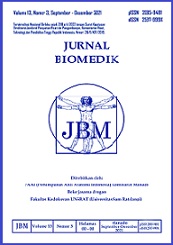PERAN SEL KUPFFER PADA STEATOHEPATITIS ALKOHOL
DOI:
https://doi.org/10.35790/jbm.4.2.2012.755Abstract
Abstract: In chronic alcohol consumption, there is an increase of intestinal mucosa layer permeability. Acetaldehyde, an alcohol metabolite, plays an important role in this change because it causes redistribution of proteins of epithelial junctions from intercellular to intracelullar locations. Therefore, gut permeability increases which leads to an increase of gut endotoxin in the portal vein. This gut endotoxin activates Kupffer cells to produce cytokines, especially TNF-α, and reactive oxygen species (ROS). These ROS activate the NF-kB pathway resulting in an increase of TNF-α production. Besides that, in hepatocytes, TNF-α can induce ROS production in mitochondria through an electron transport chain reaction. Either TNF-α or ROS has a high potential to cause liver injuries and inflammations.Key words: Kupffer cells, alcohol, liver, endotoxin
Abstrak: Pada konsumsi alkohol kronis terdapat peningkatan permeabilitas mukosa usus. Asetaldehid (metabolit alkohol) berperan penting terhadap perubahan tersebut karena bahan ini menyebabkan redistribusi protein-protein taut epitelial dari intersel ke intrasel. Peningkatan permeabilitas usus berlanjut dengan peningkatan kadar endotoksin (yang berasal dari usus) dalam darah portal. Endotoksin ini akan mengaktivasi sel Kupffer untuk memroduksi sitokin, terutama TNF-α, dan reactive oxygen species (ROS). Selanjutnya ROS akan mengaktivasi jalur NF-kB, yang menghasilkan peningkatan produksi TNF-α. Selain itu pada hepatosit TNF-α dapat menginduksi produksi ROS mitokondria melalui rantai transpor elektron. Baik TNF-α maupun ROS sangat potensial menyebabkan cedera dan inflamasi hati.
Kata kunci: sel Kupffer, alkohol, hati, endotoksin
Downloads
Issue
Section
Articles
License
Penyunting menerima sumbangan tulisan yang BELUM PERNAH diterbitkan dalam media lain. Naskah yang masuk dievaluasi dan disunting keseragaman format istilah dan cara penulisan sesuai dengan format penulisan yang terlampir dalam jurnal ini.
Segala isi dan permasalahan mengenai tulisan yang yang diterbitkan dalam jurnal menjadi tanggung jawab penuh dari penulis.







